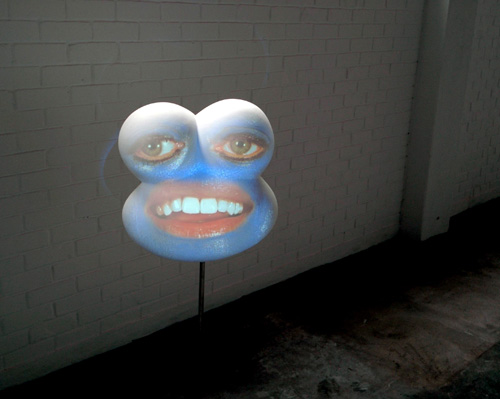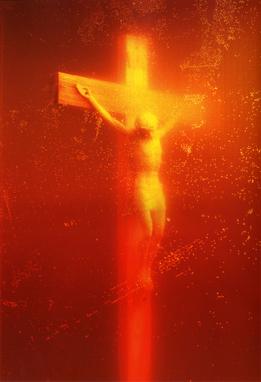Armory Show Review 2010
Keith Hoyt
While waiting in the non VIP line for the doors to open at the 2010 Armory show one couldn’t help but feel like a peasant peering over the walls of his masters estate. Viewing the works on display was like window-shopping on Fifth Avenue gazing on items too far out of your price range perhaps trying them on for a moment. The works were priced out of our league but try them on we did anyway.
I viewed the work with about as much care and interest as one would take interest in looking at the items arranged in a booth at a craft fair except when something did truly catch my eye. Jonathan Schipper’s “To Dust” two concrete cast statues grinding against each other, which if the piece were actually allowed to be activated would have ground itself to dust was one of those pieces.
Continuing on a mechanical theme was Conrad Shawcross's “Pre Retro-scope” a plywood constructed dingy with a three foot spoked wheel with a timing belt and motor which swung a projector through its circumference. The projected image was of the dingy motoring down a river. The image was not as compelling as the aesthetics of the mechanics and construction.
Daniel Joseph Martinez, “It's just a little headache, it's just a little bruise redemption of the flesh. The politics of the future as urgent as the blue sky.” 2008 and Richard Jackson's “Bad Dog” were two examples of mechanically aggressive works which spewed paint or dyed corn syrup on the galleries or collectors walls. I felt Daniel Joeseph Martinez use of prosthetic, taxidermy, metal, plastic, corn syrup, food coloring, and a pneumatic mechanical apparatus was more aggressive, elaborate and visually compelling than “Bad Dog”
Progressing on to work which was entirely digital was John Gerrard's “Lufkin Pump” a realtime 3d animation on an encased plasma screen which made it appear more like a photorealistic painting in motion. At first glance it is difficult to tell if the image is of an oil pump working in a real location but after closer inspection certain details betray the work and reveal it as a simulation. This image is again tied to mechanics. Tatsuo Myajima “LED number grid” is another piece using digital technology but in a organized but random pattern to create an evolving image with numbers reflecting digits within the digital.
Stepping away from the digital and back into the constructed is David Brooks, “Naturae Vulgaris” a concrete sidewalk brought indoors which penetrates through walls and openings directing the viewer along paths and over bridges between spaces interior and exterior. The rigging brings a tension and precariousness to the work.
If you are more comfortable being engaged by figurative work be on your guard when approaching Tony Matelli’s “Sleepwalker,” a life-size, sensuously realistic, painted bronze sculpture of a voluptuous, wild-haired woman somnambulating in her underpants. Reminiscent of Duane Hanson’s super-realist sculpture, it is the embodiment of erotic arousal untamed by ego-consciousness, a state dreamed of constantly in popular magazines and pornography.
One spectacular piece of realist painting is a full-length portrait of a nude woman by Deborah Poynton, at Stevenson. On a canvas nearly 10 feet tall and in a style reminiscent of Stanley Spencer and Lucian Freud, Ms. Poynton has painted her subject with loving attention to every stretch mark and sagging piece of flesh. The woman has a worried expression on her beautiful face, as if she were agonizing over modern culture’s loss of soul.
While at the show be sure not to miss ( you probably won't be able to) Adam McEwen’s project, I Am Curious Yellow, radiating from Nicole Klagsbrun’s booth due to the artist’s intense , but contemplative, use of the color yellow. McEwen chose to work with yellow because of the color’s ability to be vile and unpleasant, but also soothing and cheerful. His solo installation at Armory consisted of carefully selected objects placed alongside loaded imagery; jerry cans, a large yellow and white swastika, and several over-sized obituaries beneath glass, written for world champion runner Caster Semenya, were on display. Everything, even the carpet in the booth, was saturated in lemon yellow, with some white areas, and beaming in the bright lights of the fair.
This was one of the most overwhelming situations within the Armory show which brought together a abundance of both over and underwhelming work.
This years show tried something new it focused on one city Berlin a supposed hotbed of culture and compelling contemporary work. The work on display from Berlin blurred with the work from everywhere else illustrating that a western American and Eurocentric art market is alive and well and that the only influence globalism has on the art world is it's ability to generate capital for American and European shareholders to spend on art. The Armory lives up to its expectations a corral of galleries having a fire sale.




